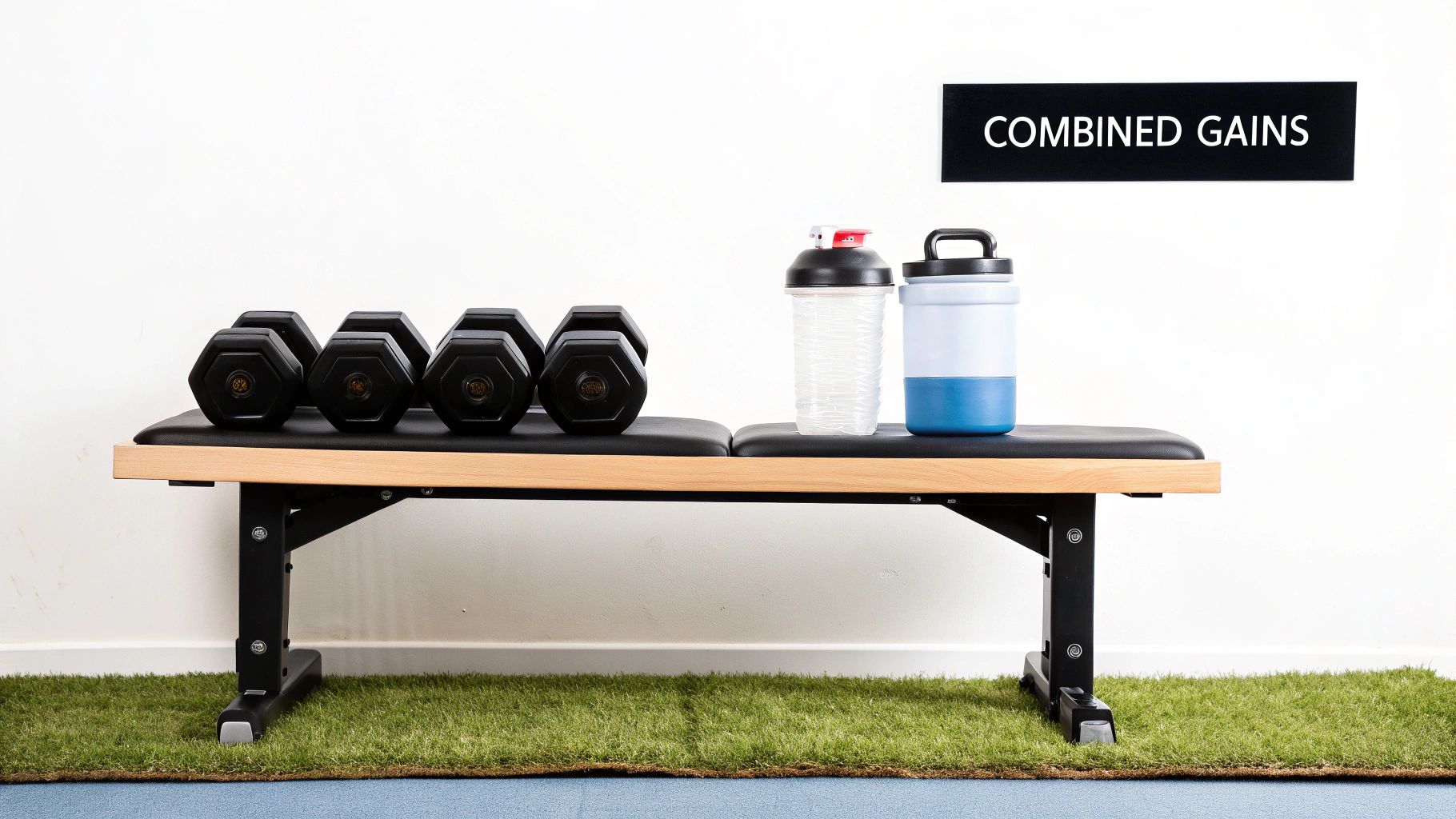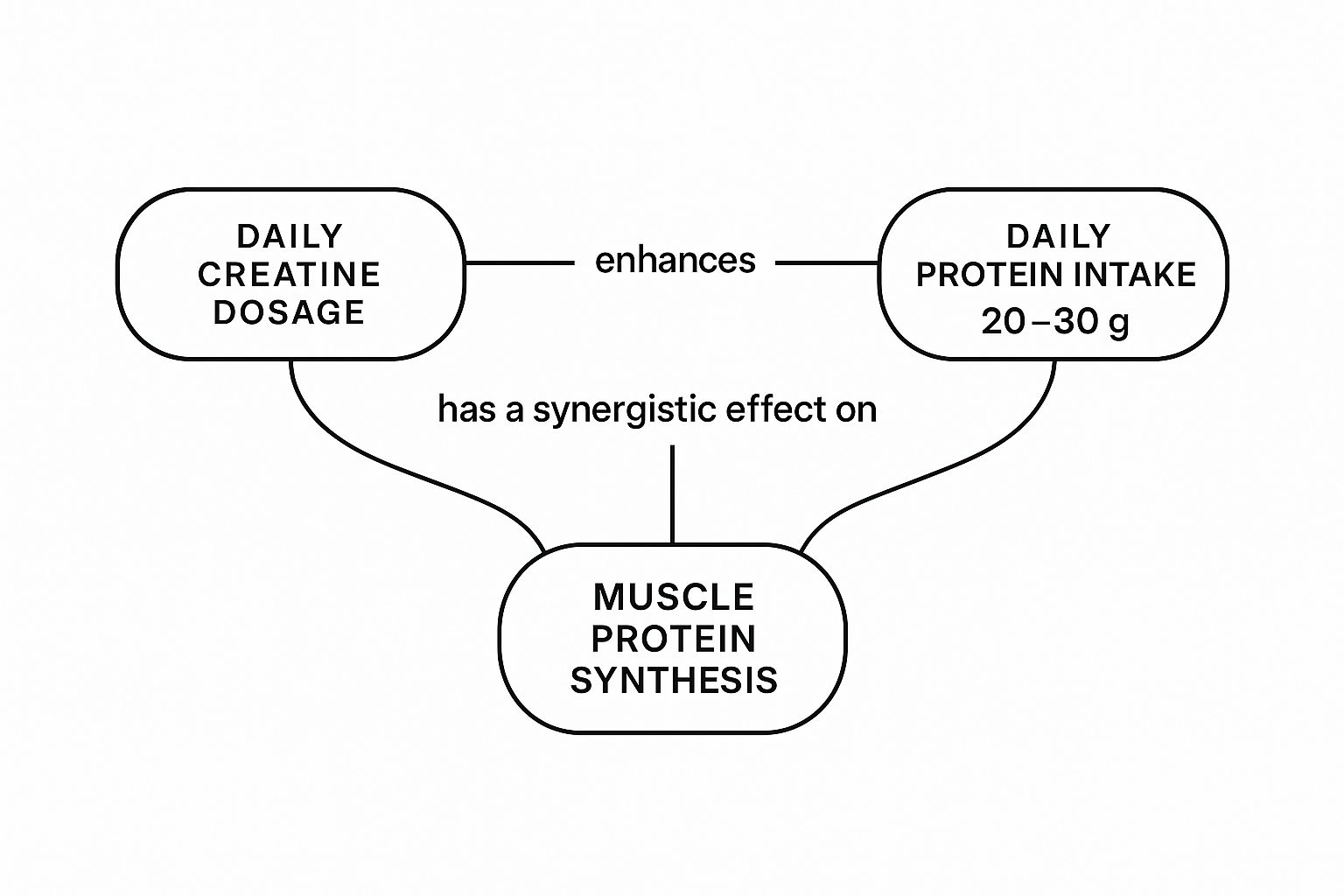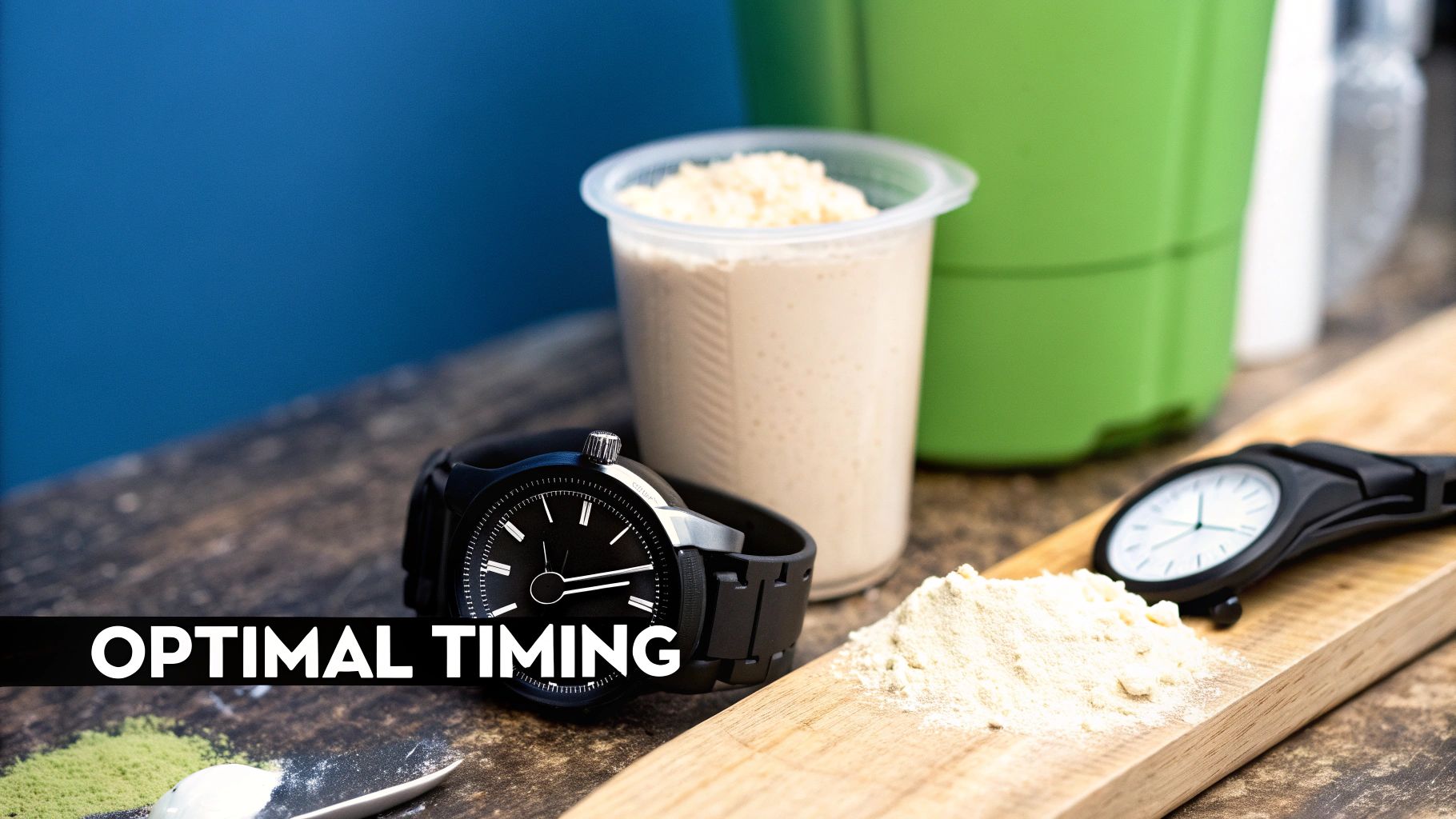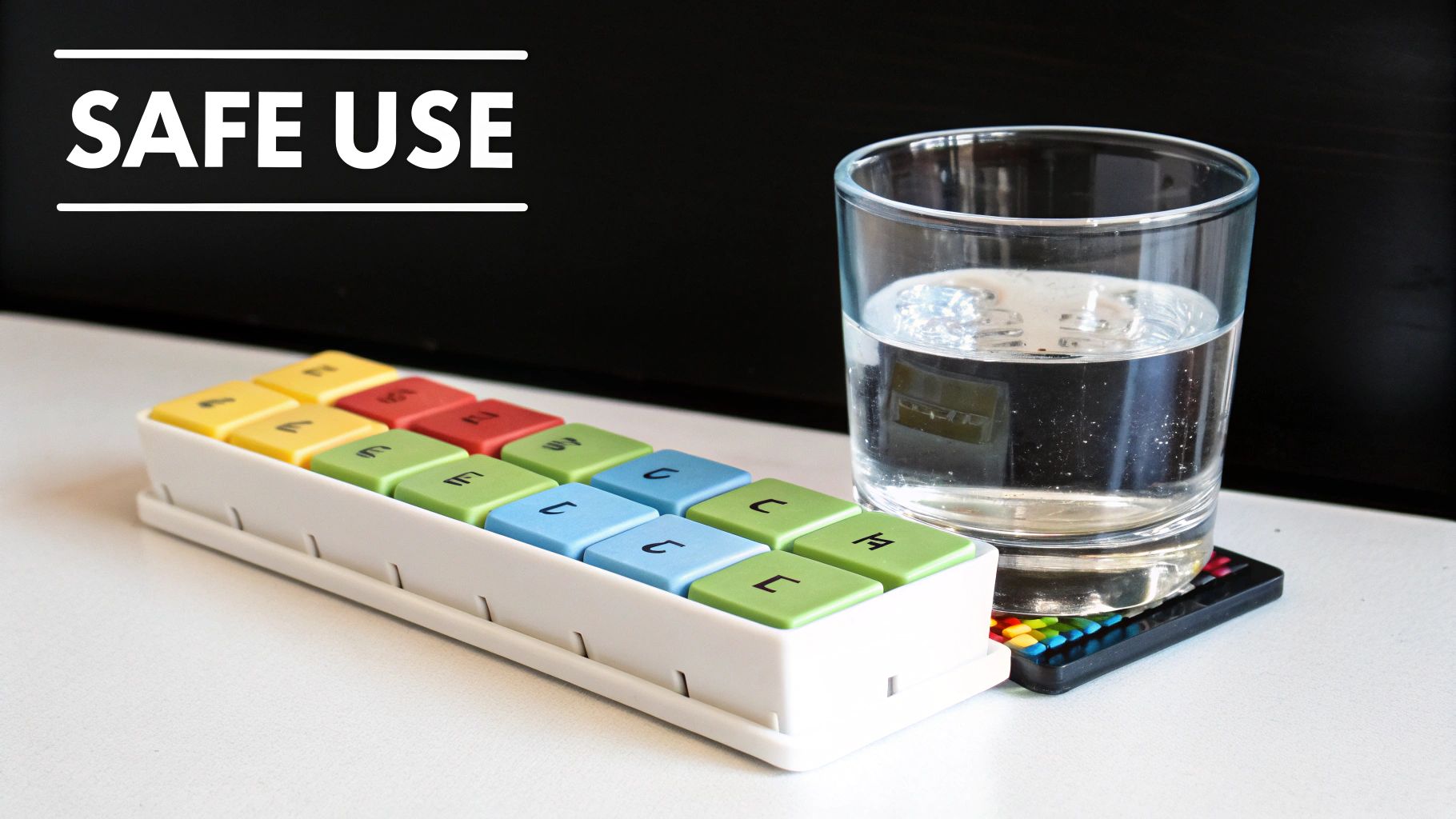
Creatine and Protein Together: Your Complete Gains Guide
Share
Why Creatine And Protein Together Create The Perfect Partnership

Picture building a high-performance skyscraper. In this massive project, protein is your essential raw material—the steel beams, concrete, and glass that create the actual structure. Protein supplies the amino acids required for muscle protein synthesis, which is the process of repairing and building new muscle tissue after a tough workout. If your construction site runs out of materials, progress stops. Protein is the foundation, providing the building blocks for strength and size.
However, having all the materials ready isn't enough. You also need a highly efficient and energetic construction crew to assemble everything quickly. This is where creatine comes into play. Creatine is like the high-energy workforce, boosting your muscles' immediate power supply. It helps regenerate ATP (adenosine triphosphate), the body’s main energy currency. This allows your crew to work harder, lift heavier beams, and get more done in less time. Taking creatine and protein together is like having a fully stocked construction site with a super-powered crew ready to build.
The Power of A True Partnership
The real effectiveness is seen when these two elements work in unison. Creatine does more than just supply energy; it fosters a cellular environment that is ready for growth. Here’s a look at how this dynamic partnership functions:
- Enhanced Work Capacity: Creatine helps you push through those last few reps or add more weight to the bar. This greater training stimulus signals a higher demand for muscle repair.
- Optimized Muscle Repair: Once the demand for repair is signaled, the protein you consume has a clear purpose. It gets to work rebuilding the muscle fibers, making them stronger than before.
- Improved Nutrient Uptake: Some studies suggest that the act of taking supplements, particularly with carbohydrates that can be paired with protein, triggers an insulin response. This can help deliver creatine into your muscle cells more effectively, making the whole process more efficient.
This combined effect is why the pairing is so favored among athletes and fitness enthusiasts. The growing recognition of these benefits is clear in the market; the global creatine supplement industry was valued at around $1.5 billion in 2024 and is expected to grow. You can explore more about the creatine market growth on thebusinessresearchcompany.com. This isn't just a fleeting interest; it's confirmation of a proven strategy. When you pair the building blocks with the energy to assemble them, you establish a powerful formula for success that neither supplement can match on its own.
The Science Behind Why These Supplements Amplify Each Other
To grasp why taking creatine and protein together delivers such powerful results, we need to peek inside the muscle cell. Imagine your muscles are a construction site. For any major building project to succeed, it needs two critical resources: a high-powered generator for immediate energy to run the heavy machinery, and a constant supply of quality building materials for new construction.
Creatine is the high-powered generator. When you perform intense exercise like lifting weights, your muscles burn through their main fuel source, ATP (adenosine triphosphate), within a matter of seconds. Creatine steps in to rapidly recharge ATP, acting like a quick-swap battery pack. This allows you to push harder—squeezing out more reps, completing more sets, or executing more explosive movements—which sends a stronger signal for your muscles to grow.
This is where protein takes over as the building material. The extra workload from your creatine-fueled training tells the construction site it's time for significant repairs and expansion. Protein provides the amino acids, which are the fundamental blocks needed to answer that call. This process, known as muscle protein synthesis, is how your muscles mend the micro-tears from training and rebuild themselves bigger and stronger. Essentially, creatine creates the demand for growth, and protein supplies the materials to meet it. To learn more about this mechanism, explore our guide on creatine for muscle growth.
Creating an Anabolic Environment
The partnership between creatine and protein runs even deeper, creating an environment ripe for muscle growth. Consuming protein, particularly when paired with carbohydrates, can trigger a small insulin response. This hormone acts like a key, unlocking your muscle cells to allow nutrients from your bloodstream to enter more easily. When creatine is in your system, this insulin response can improve its absorption into the muscles, saturating them with the energy-boosting compound more effectively.
To better understand this partnership, the following table breaks down the distinct yet complementary roles of creatine and protein.
| Function | Creatine Role | Protein Role | Combined Benefit |
|---|---|---|---|
| Energy Production | Acts as a rapid energy recharger by regenerating ATP for short, intense bursts of activity. | Provides a minimal, indirect energy source; primarily used for structure and repair. | Maximized workout intensity and volume, allowing you to train harder for longer. |
| Muscle Repair & Growth | Indirectly stimulates growth by enabling greater training stress. | Directly provides the amino acid building blocks for muscle protein synthesis to repair and build tissue. | Accelerated muscle recovery and growth as the demand created by creatine is met by protein. |
| Nutrient Transport | Can be shuttled into muscle cells more efficiently with an insulin response. | Stimulates an insulin response (especially with carbs), which enhances nutrient uptake. | Improved creatine loading and muscle saturation, leading to greater performance gains. |
| Performance Outcome | Increases strength, power output, and the number of reps you can perform. | Supports the long-term adaptation to training by building stronger, larger muscle fibers. | Synergistic effect leading to faster and more significant gains in both strength and muscle mass. |
This comparison shows that creatine and protein aren't competing for the same job; they are specialists working in tandem. One provides the power, and the other provides the materials, resulting in a far more effective muscle-building process than either could achieve alone.
This infographic visualizes how daily intake of creatine and protein work together to boost muscle protein synthesis.

The combination of creatine and protein is more than just stacking two supplements; it creates a positive feedback loop for muscle development. Some studies suggest this pairing can elevate protein synthesis rates significantly. By making sure your body has both the immediate energy for intense workouts and the essential materials for repair, you establish a potent physiological state primed for steady and noticeable progress.
Mastering The Art Of Perfect Supplement Timing
 Timing is more than a small detail—it's a factor that can mean the difference between good results and exceptional ones from your supplement routine. When taking creatine and protein together, strategic timing can amplify their effects, making sure your body is ready for both performance and recovery. While experts sometimes debate the ideal window, most agree that consistency is the ultimate key to success. The goal isn't to stress over a few minutes but to build a reliable habit that fits your training and lifestyle.
Timing is more than a small detail—it's a factor that can mean the difference between good results and exceptional ones from your supplement routine. When taking creatine and protein together, strategic timing can amplify their effects, making sure your body is ready for both performance and recovery. While experts sometimes debate the ideal window, most agree that consistency is the ultimate key to success. The goal isn't to stress over a few minutes but to build a reliable habit that fits your training and lifestyle.
Before Or After Your Workout?
The most frequent question is whether to take your supplement stack before or after you train. Solid arguments exist for both approaches, and the best choice often comes down to personal preference and how your body feels.
- Pre-Workout: Taking creatine and a fast-acting protein about 30-60 minutes before training can top off your energy reserves. Creatine ensures your muscles are saturated with the fuel needed for powerful movements, while protein supplies a pool of amino acids to help reduce muscle breakdown during your workout. Think of it as pre-loading a construction site with both the power crew and the initial materials before work begins.
- Post-Workout: This is the classic "anabolic window" idea. After a workout, your muscles are especially receptive to nutrients. Taking your creatine and protein together during this period helps jumpstart recovery and muscle protein synthesis. The protein delivers the building blocks for immediate repair, and creatine helps restore the energy you just used, preparing you for the next session.
Finding A Flexible And Effective Routine
Ultimately, the most important rule is to take your supplements consistently. Research suggests that as long as you keep your muscle creatine stores full, the exact timing is less critical than simply taking it every day. For example, if it's easier to remember your Smash.com creatine gummies with your morning protein shake on a rest day, that's perfectly fine. This consistency ensures your muscles always have the resources they need to grow and recover.
The U.S. creatine market alone was valued at around USD 419.2 million in 2024, showing just how many people are successfully adding these products to their daily lives. While powders have traditionally led sales because of their dosage flexibility, the growing popularity of convenient options like gummies signals a demand for simpler, more sustainable routines. You can read more about creatine market trends and growth. Don't let the quest for perfection get in the way of progress; find a time that works for you and stick with it for the best long-term results.
Finding Your Perfect Creatine and Protein Dosage Sweet Spot
Figuring out the right amounts of creatine and protein can feel like trying to solve a complex puzzle.## Finding Your Perfect Creatine And Protein Dosage Sweet Spot
Figuring out the right amounts of creatine and protein can feel like trying to solve a complex puzzle, but it doesn’t have to be confusing. A one-size-fits-all approach rarely works because your ideal intake depends on unique factors like your body weight, how hard you train, and your specific fitness goals. Instead of guessing, you can personalize your plan to get the most from every workout.
The objective is to find your dosage sweet spot—the amount that gives you the best results without going overboard. For most people, this means viewing creatine and protein as two separate but connected parts of a daily routine.
Tailoring Your Creatine Intake
Getting your creatine dosage right is refreshingly simple. Most scientific research points to a straightforward and effective maintenance dose that works for almost everyone.
- Standard Maintenance Dose: A daily intake of 3-5 grams of creatine is the gold standard for keeping your muscle stores full. This amount is enough for most people to see benefits in strength, power, and recovery.
- The Loading Phase Debate: Some people start with a "loading phase," taking about 20 grams of creatine per day (split into four 5-gram doses) for 5-7 days. This saturates your muscles more quickly, but it isn't required. You'll reach the same full saturation with a consistent 3-5 gram daily dose—it just takes a couple of weeks longer.
For a more detailed look at adjusting your intake based on your experience level, you can check out our complete creatine dosage guide.
Calculating Your Protein Needs
Unlike the fixed dose for creatine, protein needs can vary a lot from person to person. A solid guideline for active individuals aiming to build muscle is to consume 1.6 to 2.2 grams of protein per kilogram of body weight each day (which is about 0.7 to 1.0 grams per pound).
For instance, a 180-pound (82 kg) person would aim for roughly 126–180 grams of protein daily. This should be spread across several meals and snacks. A post-workout shake with 20–40 grams of protein is a great way to hit this target, especially when paired with your daily creatine. This timing ensures your body has the raw materials for repair when it’s most ready to use them.
To help you personalize your intake, the table below provides specific recommendations based on different training goals and body weights.
Dosage Guidelines by Training Goal and Body Weight
Comprehensive dosing recommendations for creatine and protein combinations based on individual factors and fitness objectives
| Body Weight Range | Training Goal | Creatine Dose | Protein Dose | Timing Notes |
|---|---|---|---|---|
| 120-150 lbs (54-68 kg) | Muscle Gain | 3-5 g/day | 96-150 g/day | Take creatine anytime. Aim for 20-30g of protein post-workout. |
| 120-150 lbs (54-68 kg) | Fat Loss | 3 g/day | 120-150 g/day | Creatine helps preserve muscle. Keep protein high to support satiety. |
| 151-180 lbs (69-82 kg) | Muscle Gain | 5 g/day | 120-180 g/day | Take creatine post-workout with a protein shake for better uptake. |
| 151-180 lbs (69-82 kg) | Strength/Power | 5 g/day | 105-162 g/day | Take creatine 30 mins before or immediately after your workout. |
| 181-220 lbs (83-100 kg) | Muscle Gain | 5-7 g/day | 145-220 g/day | Consider splitting protein into 4-5 meals for better absorption. |
| 181-220 lbs (83-100 kg) | Performance | 5 g/day | 126-180 g/day | Consistent daily intake of both is key. Timing is less critical. |
By aligning your creatine and protein intake with your body and goals, you create a powerful combination that supports your hard work in the gym.
What To Actually Expect From Your Supplement Stack
 Starting a new supplement routine that combines creatine and protein can be exciting, but it's important to have realistic expectations. Real progress doesn't happen overnight. Instead, it's built on small, consistent wins that accumulate over time. Based on the experiences of many athletes, here’s a straightforward timeline of what you can anticipate.
Starting a new supplement routine that combines creatine and protein can be exciting, but it's important to have realistic expectations. Real progress doesn't happen overnight. Instead, it's built on small, consistent wins that accumulate over time. Based on the experiences of many athletes, here’s a straightforward timeline of what you can anticipate.
During the first one to two weeks, the most significant change you'll likely feel is in the quality of your workouts. As creatine saturates your muscles, you might find yourself able to squeeze out an extra rep on your last set or feel more explosive during powerful movements. This isn't just in your head; it’s a direct result of your body's energy system operating more efficiently. You may also see a slight increase in body weight, which is typically just water being drawn into your muscles—a good sign that the creatine is doing its job.
Tracking Progress Beyond the Scale
As you get into your first month, the benefits will become more noticeable. This is when the true synergy of combining creatine and protein together starts to shine. You may feel less sore between training sessions, which allows you to approach your next workout with more intensity. This is the partnership at work: creatine provides the fuel for the workout, and protein helps repair the muscles afterward, leading to more effective training cycles.
To accurately measure your progress, look past the number on the scale. Focus on metrics that show real performance gains.
- Training Volume: Are you lifting more weight or completing more total reps now compared to a month ago?
- Workout Stamina: Can you maintain your intensity for longer before feeling tired?
- Recovery Time: Are you feeling rested and ready for your next session sooner?
- Physical Measurements: Use a tape measure to monitor changes in your arms, chest, and legs.
Staying Motivated for the Long Haul
After the three-month mark, you should start to see more visible changes in muscle definition and overall strength. This is where your consistent effort really pays off. One user, a 34-year-old teacher named Mark, shared that his breakthrough happened when he stopped obsessing over daily weight changes. He shifted his focus to adding five pounds to his bench press each month. "That small, achievable goal kept me motivated, and the physical results followed," he said.
If you feel like you've hit a plateau, don't worry. It's a normal part of any fitness journey. It could be a signal to change up your training routine, adjust your nutrition, or make sure you're getting enough rest. Remember, supplements are there to support your hard work, not replace it. For those looking for a more convenient alternative to powders, you can read our complete comparison in the guide on creatine gummies vs. powder. By focusing on these concrete performance indicators and celebrating small victories, you’ll build lasting momentum.
Choosing Quality Supplements That Actually Deliver Results
Walking down the supplement aisle can feel like a pop quiz you didn't study for. Countless bottles and tubs, all promising superior results, can make your head spin. To make a smart choice, you need to look past the flashy labels and focus on what really counts: quality, form, and transparency. This is how you ensure you're investing in something that will actually support your goals when taking creatine and protein together.
Evaluating Your Creatine Options
When it comes to creatine, one form stands head and shoulders above the rest: creatine monohydrate. Think of it as the gold standard. It's the most researched and trusted form for a reason—hundreds of studies consistently show it's safe and effective for building strength and improving performance. While you might see other versions like creatine HCL or buffered types, monohydrate is the most reliable choice. For most people, there's no real need to spend more on fancier alternatives that lack the same scientific backing.
Of course, the best supplement is the one you take consistently, and convenience is key. Powders have been the go-to for years, but let's be honest, they can be messy and impractical for a busy lifestyle. This is where options like Smash.com’s creatine gummies come in. They deliver a precise 5-gram dose of high-quality creatine monohydrate without any mixing or measuring, making your daily routine simple and effortless.
How to Judge Protein Quality
With protein, the number of grams per serving is just the beginning of the story. A high-quality protein source provides a complete amino acid profile, which includes all nine essential amino acids your body can't make on its own. These are the critical building blocks for muscle repair. Another vital factor is bioavailability—a term that describes how well your body can absorb and put the protein to use. Whey and casein are excellent choices because they score high in both bioavailability and amino acid content.
To get the best results, look for brands that are open about their manufacturing process. Here are a few signs of a quality product:
- Third-Party Testing: This independent check confirms that the product contains what the label claims and is free of contaminants. Look for certifications from organizations like NSF or Informed-Sport.
- GMP Certification: Good Manufacturing Practices (GMP) signal that the supplement was made in a facility adhering to strict quality control standards.
- Clear Labeling: Steer clear of "proprietary blends" that hide the exact amount of each ingredient. A trustworthy brand will be transparent about its formula.
Choosing quality supplements isn't about finding a magic fix. It’s about selecting reliable, well-researched products that fit into your daily life. By focusing on purity, proven effectiveness, and convenience, you can create a supplement plan that genuinely supports your hard work and helps you reach your goals.
Advanced Strategies For Serious Results
Once you've got the basics of dosage and timing down, you can start using more precise techniques to get more out of your efforts. Experienced athletes often adjust their supplement strategy based on their training cycles. This means changing how they take creatine and protein together to match specific goals, like building mass or leaning out. This isn't about making things complicated; it's about making small, intelligent adjustments to push past plateaus and reach a new performance level.
Tailoring Your Stack to Training Phases
Your body's needs shift depending on what you're trying to accomplish in the gym. A smart nutritional strategy recognizes and adapts to these changes.
- Bulking or Mass-Gaining Phase: When you're in a period of intense, high-volume workouts designed to build muscle, your main job is to maintain a surplus of calories and protein. This is where the synergy between creatine and protein is most powerful. You can add your daily creatine dose directly into a higher-calorie protein shake, maybe with some carbs like a banana or oats to improve nutrient delivery. The goal is to consistently fuel your performance and support muscle growth.
- Cutting or Fat-Loss Phase: During a cutting phase, the mission is to preserve the muscle you've worked hard for while being in a calorie deficit. Creatine is especially helpful here because it helps you maintain strength and workout intensity, even with less energy from food. Pair your daily creatine with a lean protein source, such as a low-carb whey isolate shake. This duo helps protect your muscle tissue from being used for energy, making sure the weight you lose comes from fat.
Beyond the Basics: Nutrient Cycling and Stacking
For those really looking to optimize, nutrient cycling can be an effective approach. This involves strategically changing your intake to keep your body responsive. For instance, some athletes consume more carbohydrates on heavy lifting days to fuel their workouts and aid recovery. On rest days, they might lower their carb intake. Throughout this cycle, a consistent daily dose of 3-5 grams of creatine and sufficient protein remains the solid foundation for progress.
Don't forget that proper hydration and quality sleep are non-negotiable. Dehydration can limit creatine's benefits, while poor sleep sabotages muscle recovery, regardless of how dialed-in your supplement plan is. When you see your creatine and protein stack as just one part of a bigger system that includes training, nutrition, and rest, you build a powerful framework for achieving significant, long-term results.
Ready to simplify your routine without sacrificing quality? Try Smash.com’s creatine gummies for a precise, delicious 5-gram dose of creatine monohydrate that fits any lifestyle.